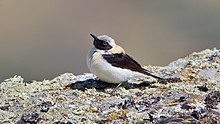| This article needs additional citations for verification. Please help improve this article by adding citations to reliable sources. Unsourced material may be challenged and removed. Find sources: "Western black-eared wheatear" – news · newspapers · books · scholar · JSTOR (December 2010) (Learn how and when to remove this message) |
| Western black-eared wheatear | |
|---|---|

| |
| male | |
| Conservation status | |
 Least Concern (IUCN 3.1) | |
| Scientific classification | |
| Domain: | Eukaryota |
| Kingdom: | Animalia |
| Phylum: | Chordata |
| Class: | Aves |
| Order: | Passeriformes |
| Family: | Muscicapidae |
| Genus: | Oenanthe |
| Species: | O. hispanica |
| Binomial name | |
| Oenanthe hispanica (Linnaeus, 1758) | |
| Synonyms | |
|
Motacilla hispanica Linnaeus, 1758 | |

The western black-eared wheatear (Oenanthe hispanica) is a wheatear, a small migratory passerine bird that was formerly classed as a member of the thrush family Turdidae, but is now considered to be an Old World flycatcher (family Muscicapidae). It was formerly (and still is by some authorities) considered conspecific with the eastern black-eared wheatear.
The breeding male has the forehead and crown white or nearly white, the mantle buff, and the wings blacker than those of the northern wheatear. The underparts are white tinged with buff. The back, upper tail coverts and most of the tail are white. A black mask extends from the ear coverts to the bill. The throat can be either black or white.
In autumn and winter the head and mantle are distinctly buff, as are the underparts (including the throat in non-black-throated individuals), but the buff varies in intensity. Except for the central pair, the tail feathers are much whiter than in the northern wheatear, the white on the inner web often extending to the tip.
The female is a browner bird, but has the characteristic white lower back, and her seasonal changes are less marked.
The male western black-eared wheatear can be distinguished from the male eastern black-eared wheatear by its more buff-tinged upperparts, giving it a less distinctly black-and-white appearance than the latter species, as well as having the black of the mask stopping at the base of the bill rather than extending slightly above. Black-throated individuals of this species have less black on the throat and face than on the eastern birds, and the black generally terminates less abruptly. Females of this species differ from their eastern counterparts in being warmer brown overall.
Taxonomy
In 1743 the English naturalist George Edwards included an illustration and a description of the western black-eared wheatear in his A Natural History of Uncommon Birds. He used the English name "The Red or Russet-colour’d Wheat-Ear". Edwards based his hand-coloured etching on a specimen owned by Mark Catesby that had been collected in Gibraltar. When in 1758 the Swedish naturalist Carl Linnaeus updated his Systema Naturae for the tenth edition, he placed the western black-eared wheatear with the wagtails in the genus Motacilla. Linnaeus included a brief description, coined the binomial name Motacilla hispanica and cited Edwards' work. The specific epithet is from the Latin Hispanicus meaning "Spanish". The western black-eared wheatear is now placed in the genus Oenanthe that was introduced in 1816 by the French ornithologist Louis Pierre Vieillot. The species is monotypic: no subspecies are recognised. The western black-eared wheatear was formerly considered to be conspecific with the eastern black-eared wheatear (Oenanthe melanoleuca). The species were split based on the results of a genetic study of the wheatears published in 2019.
The genus name Oenanthe is derived from the Ancient Greek oenos (οίνος) "wine" and anthos (ανθός) "flower". It refers to the northern wheatear's return to Greece in the spring just as the grapevines blossom. The specific hispanica is Latin for "Spanish". "Wheatear" is not derived from "wheat" or any sense of "ear", but is a 16th-century linguistic corruption of "white" and "arse", referring to the prominent white rump found in most species.
References
- BirdLife International (2019). "Oenanthe hispanica". IUCN Red List of Threatened Species. 2019: e.T22710302A155608614. doi:10.2305/IUCN.UK.2019-3.RLTS.T22710302A155608614.en. Retrieved 13 November 2021.
- Edwards, George (1743). A Natural History of Uncommon Birds. Vol. Part 1. London: Printed for the author at the College of Physicians. p. 31, Plate 31.
- Linnaeus, Carl (1758). Systema Naturae per regna tria naturae, secundum classes, ordines, genera, species, cum characteribus, differentiis, synonymis, locis (in Latin). Vol. 1 (10th ed.). Holmiae (Stockholm): Laurentii Salvii. p. 186.
- Jobling, James A. (2010). The Helm Dictionary of Scientific Bird Names. London: Christopher Helm. p. 193. ISBN 978-1-4081-2501-4.
- Vieillot, Louis Pierre (1883) . Saunders, Howard (ed.). Vieillot's Analyse d'une nouvelle ornithologie élémentaire (in French). London. p. 43.
{{cite book}}: CS1 maint: location missing publisher (link) - ^ Gill, Frank; Donsker, David; Rasmussen, Pamela, eds. (July 2021). "Chats, Old World flycatchers". IOC World Bird List Version 11.2. International Ornithologists' Union. Retrieved 3 October 2021.
- Schweizer, M.; Warmuth, V.; Kakhki, N.A.; Aliabadian, M.; Förschler, M.; Shirihai, H.; Suh, A.; Burri, R. (2019). "Parallel plumage colour evolution and introgressive hybridization in wheatears". Journal of Evolutionary Biology. 32 (1): 100–110. doi:10.1111/jeb.13401. PMID 30421480.
- Jobling, James A. (2010). The Helm Dictionary of Scientific Bird Names. London, United Kingdom: Christopher Helm. pp. 193, 280. ISBN 978-1-4081-2501-4.
- "Wheatear". Oxford English Dictionary (Online ed.). Oxford University Press. (Subscription or participating institution membership required.)
Further reading
- Ullman, Magnus (2003). "Separation of Western and Eastern Black-eared Wheatear" (PDF). Dutch Birding. 25 (2): 77–97.
External links
- Black-eared Wheatear videos, photos & sounds on the Internet Bird Collection
- Ageing and sexing (PDF; 3.8 MB) by Javier Blasco-Zumeta & Gerd-Michael Heinze